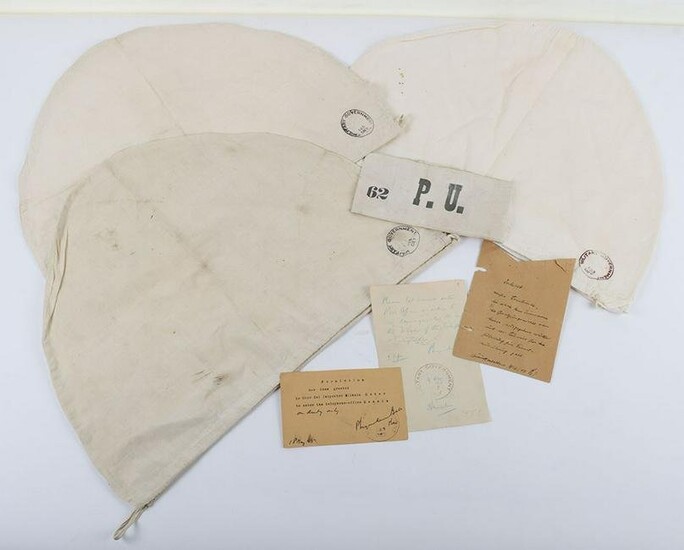Historically Interesting Albert Pierrepoint and Hamelin Prison Grouping
Historically Interesting Albert Pierrepoint and Hamelin Prison Grouping, consisting of three white cloth linen execution hoods with ink stampings for ‘MILITARY GOVERNMENT 123 DET’. Accompanied by a white cloth public witness armband with black printed ‘P.U.’ and numbered ‘62’. Printed permission slip allowing Telephone Inspector Wilhelm Oster to enter the telephone office in Hameln (Hamelin) dated 18 May 45, with signature commanding officer. Handwritten pass dated 1945, stating “Please let bearer enter Post Office in order to see damage etc. He is the Director of Telephones”, the pass being valid until 24th May 1945. The last item in the grouping is a envelope with the reverse having a inked hand written note in German from Hamelin dated 1948. The vendor states this collection was found by a refuge worker, who cleared the house of Wilhelm Oster, presumably after his death. Hamelin prison in the region of Lower Saxony, Germany, was one of the most famous prisons during WW2 and the immediate aftermath. The Third Reich and the Gestapo used this prison to imprison, interrogate and torture many of its victims. After the war it was captured by the allied forces who in turn used this as a prison and place of execution. War criminals such as Josef Kramer, Commander of Belsen Concentration Camp; Irma Grese, SS Commander Bernhard Siebken, plus many more, were all executed here. The most famous British hangman in history, Albert Pierrepoint, was the head executioner for the British government and it was he who carried out many of the executions at the prison. Albert Pierrepoint was born on 30th March 1905 in Clayton, Yorkshire. His father and his uncle were both executioners. In September 1932 he became an assistant executioner and conducted his first execution in December of that year. In 1941 he became the lead executioner for His Majesty’s Prison Service. In his 25 year career as a hangman, it is believed that he executed between 435-600 people, many of which were convicted war criminals. He retired from the service in the 1950’s and ran a pub for the rest of his working life. In 1974 he wrote his memoirs and gained more notoriety.
[ translate ]View it on
Estimate
Time, Location
Auction House
Historically Interesting Albert Pierrepoint and Hamelin Prison Grouping, consisting of three white cloth linen execution hoods with ink stampings for ‘MILITARY GOVERNMENT 123 DET’. Accompanied by a white cloth public witness armband with black printed ‘P.U.’ and numbered ‘62’. Printed permission slip allowing Telephone Inspector Wilhelm Oster to enter the telephone office in Hameln (Hamelin) dated 18 May 45, with signature commanding officer. Handwritten pass dated 1945, stating “Please let bearer enter Post Office in order to see damage etc. He is the Director of Telephones”, the pass being valid until 24th May 1945. The last item in the grouping is a envelope with the reverse having a inked hand written note in German from Hamelin dated 1948. The vendor states this collection was found by a refuge worker, who cleared the house of Wilhelm Oster, presumably after his death. Hamelin prison in the region of Lower Saxony, Germany, was one of the most famous prisons during WW2 and the immediate aftermath. The Third Reich and the Gestapo used this prison to imprison, interrogate and torture many of its victims. After the war it was captured by the allied forces who in turn used this as a prison and place of execution. War criminals such as Josef Kramer, Commander of Belsen Concentration Camp; Irma Grese, SS Commander Bernhard Siebken, plus many more, were all executed here. The most famous British hangman in history, Albert Pierrepoint, was the head executioner for the British government and it was he who carried out many of the executions at the prison. Albert Pierrepoint was born on 30th March 1905 in Clayton, Yorkshire. His father and his uncle were both executioners. In September 1932 he became an assistant executioner and conducted his first execution in December of that year. In 1941 he became the lead executioner for His Majesty’s Prison Service. In his 25 year career as a hangman, it is believed that he executed between 435-600 people, many of which were convicted war criminals. He retired from the service in the 1950’s and ran a pub for the rest of his working life. In 1974 he wrote his memoirs and gained more notoriety.
[ translate ]


